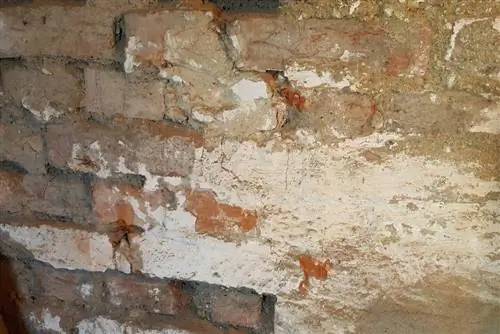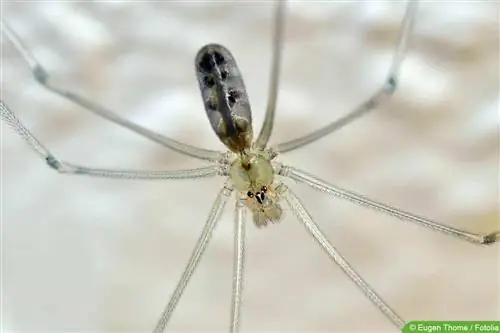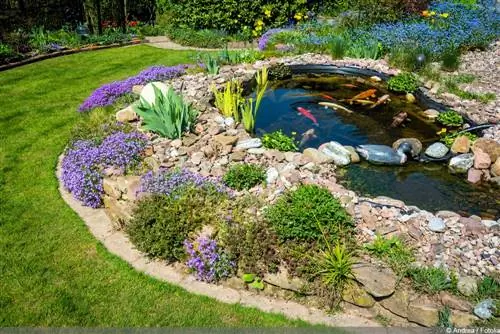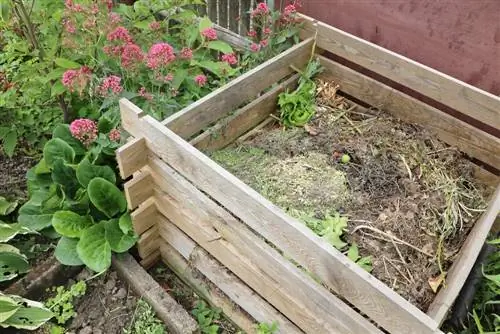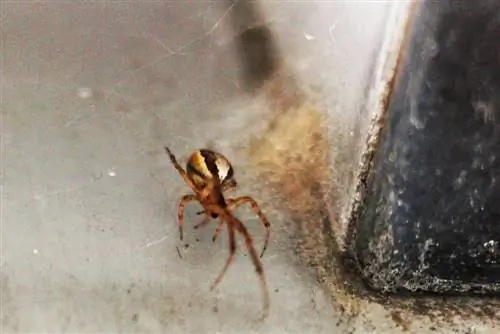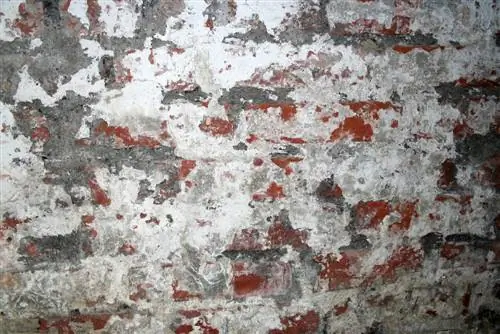- Author admin [email protected].
- Public 2023-12-17 03:39.
- Last modified 2025-06-01 06:48.
If the walls in the basement are suddenly covered with a white layer, then it is usually s altpeter. This looks very similar to white mold and is therefore often confused. S altpeter is only partially harmful to he alth, but in order to protect the masonry, it should be removed as soon as it is detected. How this can be done easily and quickly and what preventative measures should be taken is described in the following article.
S altpeter - Definition
S altpeter, which often looks very similar to the white mold on walls, is, however, so-called s alt efflorescence. S altpeter is not primarily harmful to he alth, but there is still a great danger, especially for the structure of the house, if s alt efflorescence appears. The reason for this is simple, because s altpeter usually appears on the walls when the overall environment is too humid. A scratch test can be used to determine whether there is s altpeter on the cellar walls. To do this, proceed as follows:
- S altpeter consists of minerals
- the scraped parts crystallize after drying
- this is the s alt
- S altpeter on walls is usually bright white
- Deposits on the wall are usually dry
Tip:
Mold on basement walls, on the other hand, is usually smooth and greasy, usually has a grayish color, and gives off a musty smell due to the moisture that is still present.
Fighting the causes
S altpeter can appear on the walls, especially in the basement or other storage room, under various conditions. However, if these are known, the formation of s altpeter can be prevented from the outset. As a rule, it doesn't make sense to just remove the substance from the walls. As long as the cause of the s alt efflorescence continues to exist, the s altpeter will continue to appear again and the cause will further damage the masonry. The following causes of s alt efflorescence may exist, which should be eliminated:
- S altpeter only occurs in one specific location
- The cause is usually a leaky water pipe
- can affect wastewater as well as fresh water
- Expose the line and replace the leaking piece
- Rainpipe on the outside wall is defective
- often leaks in the area of the transition to the ground
- this is how s alt efflorescence occurs in the basement on the outside wall
- Renew downpipe
- leaking terrace finish
- The only solution here is to renovate the terrace
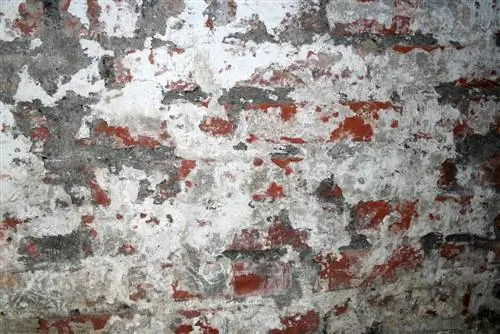
Ground or slope water that presses against the wall can also cause s altpeter on the walls in the basement. If this is the case, then only a specialist company can help, who has to drain the house from the outside in order to combat the s alt efflorescence inside and dry out the masonry.
Drain the basement after eliminating the cause
If the cause of the s alt efflorescence in the cellar has been found and remedied, only then can the s altpeter be effectively removed. However, it is not advisable to start removing s altpeter stains before drying out the basement, as they will recur if the environment continues to be damp. Even after the cause has been eliminated, the basement walls are still damp and need to be drained. The procedure is as follows:
- Air the basement well for several weeks
- depending on the cause, this can take a very long time
- use a room dehumidifier
- Can also be rented from well-stocked specialist shops
- take moisture measurements on the walls in between
- If the walls are well dry, the s altpeter can be effectively removed
Tip:
If a specialist company has been commissioned to eliminate the cause, for example because groundwater has penetrated into the masonry, then they can also take care of draining the basement.
Remove s altpeter
It is usually more difficult to remove the cause of the s alt efflorescence than to remove the s altpeter itself after the wall and the room have dried out. The work should therefore be carried out as follows:
- remove all s alt efflorescence on the walls with a wire brush
- wear long clothing, gloves and a face mask for protection
- even if s altpeter is not harmful to he alth
- a lot of dust is generated during work
- then carefully tape off parts sensitive to acid
- This includes, for example, window frames made of metal
- Apply commercial s altpeter remover over large areas
- wear protection here too
- Air the room well during work and afterwards
- After exposure time, rinse the wall well with water
Tip:
If there is a very severe infestation of s altpeter on the cellar walls, treatment with the commercially available remover is not sufficient or if the s altpeter blooms again after treatment, then a specialist company may need to be hired.
Home remedies for s altpeter
If the cause of a small infestation, for example due to a defective drain pipe, has been remedied and the cellar wall has dried out, then the resulting efflorescence can also be treated with a home remedy. In this regard, reference is often made to the power of Cola. However, this should by no means be the Light or Zero version. Then proceed as follows:
- rub affected areas with the cola
- Let it soak in for about ten minutes
- scrub the s altpeter off with a brush
- Wash the wall thoroughly afterwards
- let it dry thoroughly again
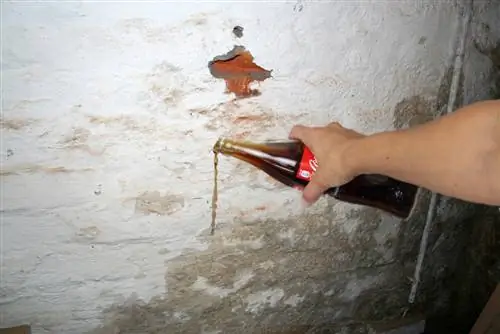
Tip:
Cola has the advantage that no chemical fumes are generated in the cellar. The disadvantage here, however, is that residue on the wall due to the sugar can be very unhygienic and could also attract more unwanted insects in the summer.
Injections to prevent neoplasms
Once s alt efflorescence has spread on a wall, it can emerge again as soon as moisture rises from below in the wall. But this can be prevented by injecting paraffin or alkali silicates directly into the masonry. If a company has been commissioned to drain the area, for example because groundwater has gotten into the cellar wall, then they will also carry out the precautionary measure against new efflorescence at the same time. But the cellar wall itself can also be protected from further moisture through injections. You should proceed as follows:
- Remove plaster, no moisture should get on the areas
- drill holes with drill
- set about ten centimeters above the ground
- Diameter from ten to twelve millimeters
- an angle of inclination between 30 and 40 degrees
- five centimeters above first row, second row of drill holes
- clean holes with vacuum cleaner
- Pour sealant into the holes using a funnel
- Let it dry and fill in the sealing again
- Working time for this can take five to ten days
After the drill holes have been filled, they are closed with sealing slurry. The wall surface is cleaned as a whole and can then be plastered.
Tip:
If the wall is very thick, you should drill from the inside and outside if possible. This is usually necessary for thicknesses of 50 centimeters and more. The drilling depth also depends on the thickness of the wall; in principle, there should be a remaining wall thickness of around five centimeters.

